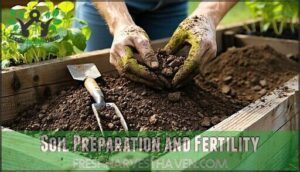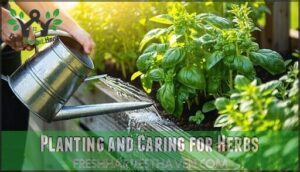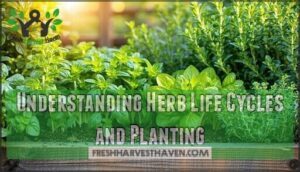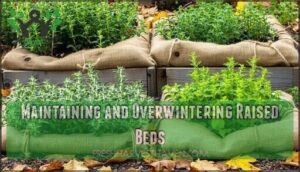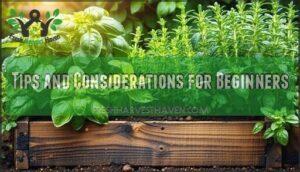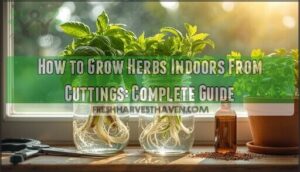This site is supported by our readers. We may earn a commission, at no cost to you, if you purchase through links.
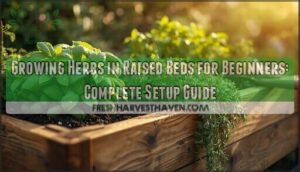
You’ll enjoy better drainage, easier maintenance, and healthier plants compared to traditional ground gardening. Choose a sunny spot with 6-8 hours of daily sunlight, then fill your bed with quality potting mix blended with compost.
Start with foolproof herbs like basil, parsley, and thyme – they’re forgiving and practically grow themselves. Plant after your last frost date, water consistently but don’t overdo it, and watch your culinary garden flourish.
The secret lies in proper spacing and understanding which herbs play well together in your miniature ecosystem.
Table Of Contents
- Key Takeaways
- Benefits of Raised Bed Herb Gardens
- Choosing The Right Location and Size
- Preparing The Raised Bed for Herbs
- Selecting Herb Varieties for Raised Beds
- Planting and Caring for Herbs
- Managing Pests and Diseases in Raised Beds
- Understanding Herb Life Cycles and Planting
- Designing and Layout of Raised Bed Herb Gardens
- Maintaining and Overwintering Raised Beds
- Tips and Considerations for Beginners
- Frequently Asked Questions (FAQs)
- Which herbs to plant together in a raised bed?
- Do herbs grow well in raised beds?
- What vegetables should not be grown in a raised bed?
- Which herbs should not be planted together?
- How deep should a raised bed be for herbs?
- What should you not grow in a raised bed?
- What is the easiest herb to grow inside?
- Can herbs grow in raised garden beds?
- Which herbs are best for a raised bed?
- Is Basil suitable for growing in a raised bed?
- Conclusion
Key Takeaways
- Choose the right location and soil mix – You’ll need 6-8 hours of daily sunlight and a blend of 50% topsoil, 30% compost, and 20% perlite for proper drainage that prevents root rot.
- Start with beginner-friendly herbs – Plant foolproof varieties like basil, parsley, and thyme that forgive mistakes while you’re learning proper spacing and watering techniques.
- Master the watering balance – Check soil moisture with your finger before watering; most herbs prefer drying out between waterings rather than staying constantly moist.
- Plan for year-round success – Group herbs by water needs, harvest regularly to encourage growth, and protect perennial herbs with mulch during winter months.
Benefits of Raised Bed Herb Gardens
When you grow herbs in raised beds, you get better drainage, healthier soil, and fewer pests to worry about, making your plants thrive with less hassle.
You’ll also enjoy easier access for planting and harvesting, plus the freedom to customize your soil mix—no more wrestling with stubborn backyard dirt, allowing for better drainage.
Improved Drainage and Soil Conditions
The soil composition in raised beds gives you complete control over your herbs’ growing environment, unlike unpredictable native soil conditions.
You’ll create ideal soil pH between 6.0-7.0 while ensuring superior improved drainage that prevents waterlogged roots.
Perfect soil pH and drainage turn your raised bed into an herb paradise where roots thrive instead of drown.
This controlled environment boosts nutrient availability and enhances water retention when needed, promoting exceptional root health for thriving beginner herbs.
Here’s your essential soil setup process:
- Layer 2 inches of gravel at the bottom for drainage
- Mix equal parts topsoil, compost, and perlite for ideal texture
- Test and adjust pH levels to the 6.0-7.0 sweet spot
- Add organic matter to guarantee sustained nutrient release
Your growing herbs will flourish in these perfectly balanced soil conditions that you’ve crafted specifically for their needs.
Better Pest Control and Accessibility
Anyone who’s wrestled with slugs or bent over weeding knows the struggle—raised beds flip the script with built-in pest barriers and ergonomic gardening perks.
The accessible design puts your herbs at arm’s reach, making pest control and harvesting a breeze. Plus, you’ll spot trouble early and react fast.
Here’s why raised bed gardening makes life easier:
- Fewer crawling pests invade your herbs
- Less back and knee strain
- Easy, frequent plant checks
- Great for vertical gardening setups
- Companion plants thrive with more control, allowing for better companion plants management.
Customizable Soil Mix and Versatility
After making your raised bed more accessible, you’ll find the real magic happens with customizable soil mixes. In raised beds, you control every scoop, making Soil Amendments, pH Balance, and Nutrient Control a breeze.
A good starting point is to aim for ideal soil texture similar to chocolate cake crumbs. Want to grow Mediterranean herbs? Try this mix:
| Herb Type | Soil Mix | Special Needs |
|---|---|---|
| Mediterranean herbs | 40% potting soil, 40% sand, 20% compost | Extra drainage |
| Moisture-loving herbs | 60% potting soil, 30% compost, 10% perlite | Water retention |
| All-purpose | 50% potting soil, 30% compost, 20% perlite | Balanced structure |
This flexibility lets you experiment with Herb Combinations and Garden Design. Adjust the soil’s pH Balance for each plant, or tweak the mix for optimal drainage. Raised beds make growing herbs less of a guessing game—just the right recipe for beginner herbs.
Choosing The Right Location and Size
Your raised bed’s location will make or break your herb garden’s success, so you’ll need at least six to eight hours of direct sunlight daily and easy access for regular care.
Consider how you’ll reach every corner for harvesting and maintenance, keeping beds no wider than four feet so you won’t strain your back stretching across them, which is crucial for the regular care of your herb garden.
Optimal Sunlight and Space Requirements
Since you’re choosing the perfect spot for your raised beds, think of sunlight exposure as your herbs’ daily fuel. Most herbs demand 6-8 hours of direct sun for herbs to thrive, making location your first critical decision. Bed orientation matters too—position your raised beds north-south so every plant catches equal rays throughout the day.
For herb spacing, treat it like arranging furniture in a cozy room. Your standard 4×8 foot bed provides ample space for beginner herbs without cramping their style. Large herbs like rosemary need 8-12 inches between neighbors, while compact herbs like thyme prefer 6-8 inches.
Don’t overlook vertical gardening opportunities—some herbs love climbing upward, maximizing your square footage. Growing herbs successfully starts with giving each plant breathing room while maximizing your harvest potential through smart spacing decisions.
Accessibility and Maintenance Considerations
Once you’ve found the perfect sunny spot, consider how you’ll actually reach your herbs.
Ergonomic height at 24-36 inches eliminates bending reduction needs while keeping everything accessible. Keep raised beds under 4 feet wide so you can reach the center without acrobatics.
Create 3-foot paths between beds for smooth movement and tool storage. Easy weeding becomes reality when you can comfortably access all areas.
Consider adaptive tools like long-handled cultivators for herb gardening success. Smart design choices like nearby water access and tool storage transform growing herbs into pure enjoyment rather than backbreaking work.
This beginner guide prioritizes accessibility and minimal upkeep.
Preparing The Raised Bed for Herbs
Once you’ve chosen your location and sized your raised bed, proper soil preparation becomes the foundation for thriving herbs.
Creating the right growing environment involves balancing drainage, fertility, and pH levels to give your herbs the best possible start.
Soil Preparation and Fertility
Before you start growing healthy herbs, you’ll need to create the perfect soil foundation. Your herb garden’s success depends on getting this vital step right from the beginning.
Start with a balanced soil mix that provides everything your herbs need:
- Topsoil (50%) – Gives essential structure and base nutrients for strong root systems
- Compost (30%) – Adds organic matter and beneficial microbes that boost plant health
- Peat moss (20%) – Maintains moisture while ensuring proper drainage isn’t compromised
Test your soil pH before planting since herbs thrive in slightly acidic conditions around 6.5. Most herbs benefit from neutral to alkaline soil for ideal nutrient absorption.
Unlike heavy-feeding vegetables, most herbs actually develop better flavor in moderately fertile soil rather than nutrient-rich environments. For peak growth, make certain your herbs get 6-8 hours daily of direct sunlight.
Smart soil preparation means avoiding synthetic fertilizers initially. Instead, work compost additions into your mix and plan for gentle, ongoing nutrition. Consider balanced soil amendments like aged manure or worm castings for sustained nutrient balance.
Remember that excellent soil quality creates the foundation for flavorful herbs that’ll make your cooking shine.
Drainage and Water Management
With your soil ready, proper drainage keeps herbs healthy.
Place 2 inches of drainage materials like gravel at the bottom, then landscape fabric to prevent soil washout. Mix perlite into your soil for Mediterranean herbs needing drier conditions.
Many gardeners find it helpful to source materials for raised beds online.
Watering frequency depends on weather, but water at plant bases using soaker hoses for consistent soil moisture. Overwatering prevention is key—most herbs prefer drying between waterings.
Your finger makes the best moisture meter for checking soil drainage in your raised beds.
Selecting Herb Varieties for Raised Beds
When choosing herbs for your raised bed, you’ll want to take into account each plant’s growth habits, water needs, and how often you’ll actually use them in your kitchen.
It’s easy to get excited and plant every herb you see, but matching varieties to your climate and cooking preferences will set you up for a thriving, low-maintenance garden.
Perennial Herbs and Their Characteristics
Perennial herbs become your garden’s reliable backbone, offering years of harvests from a single planting. These hardy survivors like rosemary, thyme, and oregano develop extensive root systems and impressive winter hardiness once established.
Lifespan expectations stretch decades for woody herbs like sage, while softer perennial herbs like chives regenerate annually from their crowns. Mature size varies dramatically—compact thyme stays under six inches while rosemary can tower three feet in raised beds.
Propagation methods include division, cuttings, and layering, making expansion affordable. Mediterranean varieties thrive in raised beds’ superior drainage, developing concentrated flavors that surpass container-grown counterparts. Many gardeners find success by using well-draining soil.
For successful herb gardening, position larger perennials like lavender at bed edges where their mature size won’t shade smaller plants. Growing herbs this way maximizes your investment while ensuring consistent herb care requirements.
Annual Herbs and Their Requirements
Three seasonal performers steal the show in raised bed herb gardening. Annual herbs like basil, cilantro, dill, and parsley complete their entire lifecycle in one growing season, making them perfect candidates for experimenting with different varieties each year.
Understanding their unique requirements guarantees abundant harvests:
- Succession planting every 2-3 weeks maintains continuous supply throughout the season
- Direct sowing works best for cilantro and dill since their delicate roots dislike transplanting
- Replanting frequency varies—basil thrives all summer while cilantro needs cool-weather replacements
- Soil nutrients should be moderate; over-fertilization dilutes essential oils in most herbs
These sprinters demand timing precision. Plant basil after soil warms to 60°F, but get cilantro in the ground while temperatures stay below 75°F. Common problems include bolting in heat-sensitive varieties and inadequate watering during establishment.
Growing herbs successfully means embracing their fleeting nature. Regular harvesting encourages bushier growth and delays flowering, extending productivity. In raised beds, these annual performers benefit from the superior drainage and soil control, often outperforming their container-grown cousins by significant margins.
Culinary Herbs and Companion Planting
Beyond individual herbs, culinary synergy emerges through strategic companion planting.
Growing herbs together creates aromatic combinations that enhance flavor pairings while doubling as natural pest deterrents.
Basil alongside tomatoes improves taste, while rosemary and sage protect brassicas from cabbage moths.
These pollinator attractors support your entire garden ecosystem.
Herb Growing Partner Pests Repelled
Exercise caution with mint—it’s an aggressive spreader that’s best contained separately.
Lavender uses extend beyond cooking; it attracts pollinators while deterring unwanted insects.
For beginner herb gardening success, group plants with similar water needs together in your raised beds, ensuring harmonious growth and easier maintenance.
Planting and Caring for Herbs
Once you’ve prepared your raised bed with quality soil, you’re ready to plant your herbs and establish a care routine that keeps them thriving.
Proper timing, consistent watering, and regular maintenance will transform your raised bed into a productive herb garden that provides fresh ingredients throughout the growing season.
Planting Time and Soil Conditions
Timing sets the foundation for thriving herb gardens in raised beds. You’ll want to wait until nighttime temperatures stay consistently above 50°F before transplanting seedlings or direct seeding most herbs outdoors.
Perfect soil conditions make all the difference for successful herb gardening:
- Create the ideal soil mix using 50% topsoil, 30% compost, and 20% perlite or coarse sand for excellent drainage
- Test your soil’s pH level with a simple kit, aiming for 6.0-7.0 (that sweet spot most herbs crave)
- Add organic soil amendments like aged compost or worm castings to boost nutrients naturally
Early spring planting works best for cool-season herbs like cilantro and dill, while warm-season favorites like basil prefer late spring timing. Consider purchasing pre-mixed garden soil for convenience. Your raised beds will warm up faster than ground-level gardens, giving you a head start on the growing season. Remember, watering needs vary by herb type, so group similar plants together for easier maintenance.
Watering and Nutrition Requirements
With your herbs planted, proper watering and nutrition keep them thriving without drowning them in attention.
Watering frequency depends on your raised bed’s drainage and weather. Check soil moisture by inserting your finger 1-2 inches deep—water only when dry. Your herb garden soil should feel like a wrung-out sponge, not soggy or bone-dry.
Overwatering signs include yellowing leaves, wilting despite wet conditions, and that funky smell of rotting roots. Most herbs prefer "tough love" watering—deep drinks less often rather than daily sprinkles. To avoid issues, remember that soil type impacts drainage.
For nutrition, herbs actually prefer lean conditions. Monthly diluted organic fertilizer or compost tea provides adequate nutrients. Nutrient deficiencies show as pale leaves or stunted growth, but over-fertilizing creates lush foliage with weak flavors.
- Water at soil level to prevent fungal diseases on leaves
- Monitor soil pH between 6.0-7.0 for ideal nutrient uptake
- Apply fertilizing herbs treatments monthly during growing season
- Follow herb care tips: less is often more with both water and nutrients
Remember, stressed herbs often develop stronger flavors—like people, a little challenge builds character.
Pruning and Harvesting Techniques
If you want lush, flavorful herbs from your raised beds, a little regular “haircut” goes a long way. Pruning herbs isn’t just about keeping things tidy—it’s about boosting growth and flavor. Use clean, sharp scissors or pruners for precise cuts just above a leaf node. This encourages bushier plants and helps prevent disease.
For ideal results, consider using specialized herb trimming tools. Pruning frequency varies: basil thrives with weekly trims, while woody herbs like rosemary need less frequent attention. Always pinch off flower buds unless you’re saving seeds; this keeps the plant’s energy focused on tasty leaves.
Harvesting methods matter, too. For annuals like cilantro, never cut more than a third of the plant at once. Perennials can handle a bit more. Early morning is the best time for herb harvesting—essential oils are at their peak, enhancing flavor.
In regard to herb storage, dry bundles or freeze chopped herbs in olive oil cubes for year-round use.
| Pruning Frequency | Harvesting Methods |
|---|---|
| Basil: Weekly | Cut 1/3 for annuals |
| Rosemary: Monthly | Heavier for perennials |
| Mint: Biweekly | Early morning for flavor |
Managing Pests and Diseases in Raised Beds
While raised beds naturally reduce many pest problems, you’ll still need to stay vigilant about common issues like aphids, spider mites, and fungal diseases that can affect your herbs.
The good news is that managing these problems in raised beds is easier than traditional gardens, and you can use simple organic methods that won’t harm your family or the beneficial insects that help your garden thrive.
Natural Pest Control Methods
Your herb garden’s thriving, but unwanted visitors might crash the party. Natural pest control keeps your herbs safe without harsh chemicals that could end up in your cooking.
Keep your herbs protected naturally—your cooking deserves chemical-free ingredients.
Physical barriers and organic sprays create an effective defense system for raised beds. These natural remedies protect your herb garden while maintaining the quality you expect from homegrown herbs.
Here are four proven pest deterrents for natural herb gardening:
- Row covers – Fine mesh fabric blocks flying insects while allowing sunlight and water through
- Neem oil spray – Apply weekly to leaves; this organic solution disrupts pest life cycles
- Soap spray – Mix 2 tablespoons mild dish soap per quart water for soft-bodied insects
- Diatomaceous earth – Sprinkle food-grade powder around plants to deter crawling pests
Remove garden debris regularly since it harbors pests. These homemade remedies and companion plants work together, creating a pest-resistant environment where beneficial insects can thrive naturally.
Companion Planting and Beneficial Insects
Smart companion planting turns your raised herb bed into nature’s own security system.
Research shows companion planting herbs can reduce pest infestations by up to 40%, making this strategy invaluable for natural pest control.
When attracting pollinators, flowering herbs like dill and cilantro draw beneficial insects that consume hundreds of aphids daily.
Strategic herb combinations work wonders—basil paired with tomatoes improves flavor while repelling pests, and chives planted near roses create protective barriers.
Rosemary and thyme form powerful garden pairings that deter cabbage moths and whiteflies from neighboring crops.
Mint requires special containment since its aggressive roots disrupt ecosystem balance.
Let some herbs bolt to extend nectar sources for beneficial insects over 10-12 weeks.
Calendula and borage boost bee presence by 30%, while ladybugs and parasitic wasps establish residence in diverse herb plantings.
This creates a self-regulating garden ecosystem where good bugs handle pest problems naturally.
Homemade Sprays and Organic Solutions
While beneficial insects provide excellent natural protection, sometimes you’ll need backup solutions for stubborn pests threatening your organic herbs.
Kitchen ingredients make surprisingly effective DIY pesticides for your raised beds. These homemade sprays offer gentle yet powerful pest control without harsh chemicals that could contaminate your culinary harvest.
Here are proven organic solutions you can whip up in minutes:
- Soap solutions: Mix 1 tablespoon castile soap per quart of water for soft-bodied insects
- Oil sprays: Combine 2 teaspoons neem oil with mild soap and water as a multipurpose repellent
- Garlic spray: Blend 5 crushed cloves with water, strain, and spray for aphid control
- Herbal remedies: Steep wormwood or tansy tea for natural fungicides against powdery mildew
Apply weekly during peak pest season for maximum effectiveness.
Understanding Herb Life Cycles and Planting
Understanding when to plant different herbs makes the difference between a thriving garden and a struggling one.
You’ll discover that knowing whether your herbs are annuals, perennials, or biennials helps you plan spacing, timing, and which varieties to grow together for maximum success.
Perennials and Biennials in Raised Beds
After keeping pests in check, it’s time to think about the long game—growing perennial and biennial herbs in your raised beds.
Perennial herbs like rosemary, thyme, and sage are the reliable workhorses, sticking around year after year if you give them what they need.
Biennial herbs, such as parsley, follow a two-year rhythm, rewarding patience with lush leaves before flowering in the second season.
To keep your herb garden thriving, enrich your soil mix with compost every spring.
Space requirements matter: give perennials 12–18 inches to stretch out and breathe.
Mint’s wild side means it’s best corralled in its own container.
For perennial overwintering, mulch heavily to protect roots from winter chills.
Light pruning of woody perennials in early spring encourages bushier, healthier growth.
Companion planting can maximize space and boost yields, making your raised beds both productive and beautiful.
- Amend soil annually with compost for nutrient-rich, vibrant herbs.
Annuals and Succession Planting
While perennials stay put year after year, annual herbs offer something different: flexibility and continuous harvest potential through smart succession benefits.
These one-season wonders complete their lifecycle quickly, but that’s your advantage.
Succession planting transforms your raised bed into a non-stop flavor factory. Instead of planting everything at once, you’ll use staggered planting techniques with strategic planting windows.
- Sow cilantro seeds every 3 weeks in fresh soil mix – it bolts fast in heat
- Start new basil batches as older plants slow their production
- Plant dill every 2-3 weeks for tender fronds all season
- Rotate chervil plantings throughout spring and fall months
This annual rotation system keeps your harvest basket full while maximizing your raised bed space. Smart watering schedules support each generation of herbs as they mature.
You’ll discover that annual herbs actually give you more control over your garden’s productivity than any perennial ever could.
Spacing and Interplanting Considerations
Your raised bed isn’t just dirt—it’s prime real estate where herb density determines success.
Give larger herbs like rosemary 8-12 inches, smaller varieties like thyme 6-8 inches. Vertical growth matters too; tall dill can steal sunlight access from shorter herbs below.
Root competition intensifies in cramped quarters, stunting growth. Smart interplanting delivers companion benefits—basil near tomatoes enhances flavor while deterring pests.
Consider herb varieties carefully: aggressive spreaders like mint need barriers. Plant spacing prevents plant competition for nutrients and air circulation.
Companion planting maximizes your spacing strategy. Remember, crowded herbs struggle while sparse planting wastes precious space.
Designing and Layout of Raised Bed Herb Gardens
Creating the perfect layout for your raised herb garden isn’t just about throwing plants into a box—it’s about designing a space that works for both you and your herbs.
You’ll want to take into account everything from how tall you’re (no one enjoys doing yoga poses just to harvest basil) to which herbs play nicely together and which ones might try to take over your entire garden like mint on a mission, acting with a sense of purpose and aggression that can be described as being on a mission.
Traditional and Floating Raised Bed Designs
Now that you understand herb life cycles, choosing the right raised bed design will shape your garden’s success.
Two main options exist: traditional permanent structures and floating designs that rest directly on existing surfaces.
Traditional raised beds create a solid foundation for your herb garden design. These permanent structures typically measure 4 feet wide by 8 feet long, allowing easy access from all sides.
Frame construction determines longevity and garden aesthetics. Consider these bed materials for superior results:
- Cedar frames provide 10-15 years of rot-resistant, chemical-free durability
- Galvanized metal beds offer modern design aesthetics with exceptional strength
- Recycled plastic lumber delivers decades of maintenance-free performance
- Concrete blocks create affordable, customizable herb garden layout options
- Composite materials blend natural beauty with long-lasting resilience
Floating raised beds offer excellent mobility options, making them perfect for renters or those wanting flexibility. These designs utilize water reservoirs beneath the soil, reducing irrigation needs by up to 50% in water-scarce areas.
They’re ideal for patios and rooftops where traditional garden layout isn’t possible. Both styles support vertical additions like trellises for climbing herbs, maximizing your growing space.
Accessible and Space-Efficient Layouts
Making your herb garden layout work for you starts with smart design choices that prioritize accessibility and maximize your growing space.
Smart garden layout means every herb stays within easy reach.
- Keyhole design creates horseshoe-shaped raised beds where you can access all plants without stepping on soil—perfect for your back and knees.
- Vertical structures like tiered gardens against walls or fences give climbing herbs like rosemary and trailing thyme prime real estate while saving ground space.
- Container integration near kitchen doors lets you snip fresh herbs while cooking—no muddy garden treks required.
- Pallet gardens transform cramped spaces into productive growing areas, stacking herbs vertically when horizontal space runs short.
Group herbs by water needs in your herb garden design—keep thirsty basil separate from drought-loving sage.
This herb garden layout saves water, time, and prevents overwatering disasters.
Your raised beds become efficient herb havens where everything’s within arm’s reach, making garden maintenance feel less like work and more like a pleasant daily ritual.
Maintaining and Overwintering Raised Beds
Once your herbs are established, proper maintenance guarantees they’ll thrive year after year in your raised bed.
The key to success lies in regular care during the growing season and protecting your perennial herbs when winter arrives, which is crucial for their survival and ensures they will thrive.
Regular Pruning and Mulching
Two simple habits keep your herb garden thriving year-round. Regular pruning maintains plant health while mulching protects roots and conserves moisture.
| Pruning Techniques | Mulch Types |
|---|---|
| Remove yellow leaves weekly | Straw (2-3 inches deep) |
| Pinch flower buds for leafy growth | Shredded leaves for Weed Control |
| Harvest maximum 1/3 at once | Wood chips for Moisture Retention |
Clean your tools between plants to prevent disease spread. Apply mulch around plants, keeping it away from stems.
Herb pruning varies by type—basil needs frequent attention while woody herbs like rosemary require less. This routine guarantees maximum Herb Health throughout the growing season.
Protecting Perennials From Cold Temperatures
Most perennial herbs naturally enter dormancy when winter arrives, requiring thoughtful protection to survive harsh conditions.
Apply winter mulching around plant bases using 3-4 inches of organic material, keeping it 2 inches away from stems to prevent rot and fungal issues.
Your frost protection strategy should include:
- Wrapping tender perennials like rosemary in breathable burlap to shield from drying winds while maintaining airflow
- Creating simple cold frames using old windows or clear plastic sheeting for cold-hardy varieties that can handle light frosts
- Considering container overwintering by moving potted herbs to unheated garages or protected areas during extreme cold temperatures
Proper dormancy care guarantees your overwintering herbs emerge healthy and vigorous when spring returns.
Preparing for Spring Growth
Everyone knows spring preparation separates successful herb gardeners from weekend warriors.
Start your raised beds comeback by removing winter debris and testing soil temperature—you’ll want it reaching 50°F consistently.
Then it’s time to roll up your sleeves:
- Soil amendments: Add 2-3 inches of fresh compost for nutrient boost
- Seed starting: Begin indoor germination 6-8 weeks before last frost
- Frost protection: Ready row covers for unexpected cold snaps
- Tool sharpening: Clean and sharpen pruners for precise cuts
- Garden planning: Map out this year’s herb layout on paper
Your mulch comes off gradually as plant energy awakens underground.
Tips and Considerations for Beginners
Starting your first raised bed herb garden doesn’t have to be overwhelming if you avoid a few common pitfalls and make smart choices from the beginning.
You’ll save time and money, and frustration by learning what works best before you invest in materials and plants.
Common Mistakes to Avoid
After winter prep, avoid these costly beginner blunders that’ll sabotage your raised bed success.
Overwatering Herbs kills more plants than drought—check soil moisture before watering. Poor Drainage creates soggy conditions that rot roots, so guarantee proper soil mix. Neglecting Sunlight requirements (6+ hours daily) stunts growth substantially.
| Mistake | Problem | Solution |
|---|---|---|
| Wrong Spacing | Crowded herbs get disease, compete for nutrients | Follow spacing guidelines: 6-8 inches for small herbs |
| Ignoring pH | Nutrient lockout, poor growth | Test soil regularly, maintain 6.0-7.0 pH |
| Dense Watering | Root rot, fungal issues | Water deeply but infrequently, check drainage |
These mistakes turn promising raised beds into herb graveyards.
Choosing The Right Raised Bed Materials
Building your herb garden starts with smart material choices that won’t break the bank or your back. Once you’ve avoided the common pitfalls, selecting the right raised bed materials becomes your foundation for gardening success.
Here are your top raised bed materials to examine:
- Untreated cedar boards – naturally rot-resistant, lasting 10-20 years
- Galvanized steel – sleek metal options with 30-year durability
- Stone beds – permanent, beautiful, excellent heat retention
- Composite lumber – recycled materials offering 20+ year lifespan
- Untreated pine – budget-friendly at $2-4 per linear foot
Wood durability varies dramatically. Cedar costs more upfront but outlasts cheap pine by decades. Premade raised bed frames save time but cost more than DIY builds. Metal options heat up quickly, benefiting spring growth but requiring summer monitoring.
For cost analysis, untreated pine wins short-term, while cedar and composite materials provide better long-term value. Upcycled materials like reclaimed wood reduce costs and environmental impact. Avoid pressure-treated lumber near edibles – stick with food-safe options for your herbs.
Starting Small and Expanding Your Herb Garden
Now that you’ve chosen your materials, it’s time to embrace the "start small, dream big" approach to herb gardening.
| Garden Stage | Best Herbs | Expected Timeline | Key Learning |
|---|---|---|---|
| First Container | Basil, chives | 2-4 weeks | Watering basics |
| Small Raised Bed | Add parsley, oregano | 6-8 weeks | Spacing skills |
| Expanded Garden | Rosemary, thyme, sage | Full season | Advanced care |
| Advanced Setup | Mint, cilantro succession | Year-round | Garden mastery |
Begin with easy herbs you’ll actually cook with—there’s nothing worse than a neglected garden gathering dust. Container herbs let you test your green thumb before committing to raised beds. Budget gardening means starting with three beginner herbs rather than filling an entire bed immediately.
Seed starting saves money, but cuttings from friends work faster for building confidence. Once you’ve mastered basic watering and harvesting, gradual expansion feels natural. Your starting herb garden becomes the foundation for bigger herb garden ideas down the road, allowing for gradual expansion and eventually garden mastery.
Frequently Asked Questions (FAQs)
Which herbs to plant together in a raised bed?
Plant Mediterranean herbs like rosemary, thyme, and oregano together since they prefer drier soil. Group tender herbs like basil, parsley, and cilantro separately for easier watering management.
Do herbs grow well in raised beds?
Herbs happily thrive in raised beds, relishing roomy roots and rapid drainage.
You’ll dodge soggy soil and stubborn weeds, making maintenance a breeze.
With sunlight and the right soil mix, you’ll harvest healthy, flavorful herbs all season.
What vegetables should not be grown in a raised bed?
Skip planting deep-rooted crops like corn or large vining plants such as pumpkins in raised beds—they need more space and support than most beds offer.
Potatoes can struggle too, since they require deep, loose soil for tuber growth, and this is a key consideration for raised beds.
Which herbs should not be planted together?
Don’t plant mint with other herbs—it’ll take over your entire bed. Keep fennel separate too, as it inhibits growth in nearby plants through chemical compounds it releases.
How deep should a raised bed be for herbs?
Most herbs thrive in raised beds that are 10-12 inches deep.
This depth provides adequate root space while ensuring proper drainage.
You can go deeper for perennial herbs like rosemary, but 12 inches works perfectly for most varieties.
What should you not grow in a raised bed?
Avoid large trees, deep-rooted vegetables like carrots, and invasive plants like mint without containers. Don’t grow corn, melons, or sprawling squash that’ll overwhelm your space and neighboring herbs.
What is the easiest herb to grow inside?
If you’re looking for a low-maintenance indoor herb, go with basil.
It grows quickly on a sunny windowsill, asks for little more than regular watering, and rewards you with fresh leaves for pasta or sandwiches.
Can herbs grow in raised garden beds?
Absolutely, you’ll find herbs flourish beautifully in raised beds! They offer better drainage, warmer soil, and easier access. Most culinary favorites like basil, thyme, and parsley thrive in this setup.
Which herbs are best for a raised bed?
Basil, parsley, thyme, chives, oregano, and sage thrive in raised beds, thanks to good drainage and easy care.
Mint works too, but keep it contained—mint’s like that friend who never knows when to leave.
Is Basil suitable for growing in a raised bed?
Yes, basil thrives in raised beds! It’s actually one of the easiest herbs for beginners. You’ll love the improved drainage and warmer soil that help basil flourish beautifully.
Conclusion
Statistics show that herb gardeners using raised beds report 40% higher success rates than traditional ground gardeners.
Your journey with growing herbs in raised beds for beginners doesn’t end here—it’s just beginning. You’ve learned the fundamentals of soil preparation, plant selection, and maintenance that’ll keep your culinary garden thriving year-round.
Remember, every expert gardener started exactly where you’re now. Start small, stay consistent with watering and harvesting, and don’t be afraid to experiment with new varieties as your confidence grows.


